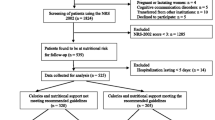Abstract
Background The abuse and deficiency of nutritional support coexist in China, and clinical pharmacists have responsibilities to promote the rational use of drugs. Objective Apply the Screening Tool Risk on Nutritional Status and Growth to observe the influence of parenteral nutrition on children with an incarcerated hernia and educate physicians to promote the rational use of parenteral nutrition. Setting Department of General Surgery of Nanjing children’s hospital. Method Patients were grouped according to the sores of Screening Tool Risk on Nutritional Status and Growth, and each group was then divided into subgroups according to receiving parenteral nutrition only (subgroup A) or no extra nutritional support (subgroup B). The clinical results were compared to ascertain whether parenteral nutrition was necessary, and the clinical pharmacists educated the physicians according to the results. One year later, the clinical results before and after education were compared. Main outcome measure Nutritional indicators (body weight, albumin, prealbumin, retinol binding protein), length of hospital stay after operation, hospitalization cost and incidence of adverse reactions. Results There were no significant differences in changes of nutritional indicators between the A and B subgroups of the score 1 and 2 groups. In the score 3 group, decreases of nutritional indicators were more pronounced in subgroup B than in subgroup A, and the length of hospital stay after operation was significantly shorter in subgroup A. The incidence of adverse reactions was significantly higher for those who received parenteral nutrition. One year after the clinical pharmacists educated the staff, the use of parenteral nutrition, hospitalization cost and incidence of adverse reactions significantly decreased. Conclusions Clinical pharmacists played an important role in improving the rational use of parenteral nutrition.
Similar content being viewed by others
References
Li XX, Liu F, Zhai SD. The present situation and controversial issues of nutrition support in clinic. Chin J Drug Appl Monit. 2015;12:116–9.
Kondrup J, Allison SP, Elia M, Vellas B, Plauth M. Educational and clinical practice committee, European society of parenteral and enteral nutrition (ESPEN). ESPEN guidelines for nutrition screening 2002. Clin Nutr. 2003;22:415–21.
Teixeira AF, Viana KD. Nutritional screening in hospitalized pediatric patients: a systematic review. J Pediatr (Rio J). 2016;92:343–52.
Galera-Martínez R, Moráis-López A, de la RiveroRosa MD, Escartín-Madurga L, López-Ruzafa E, Ros-Arnal I, et al. Reproducibility and Inter-rater reliability of 2 paediatric nutritional screening tools. J Pediatr Gastroenterol Nutr. 2017;64:e65–70.
Tuokkola J, Hilpi J, Kolho KL, Orell H, Merras-Salmio L. Nutritional risk screening—a cross-sectional study in a tertiary pediatric hospital. J Health Popul Nutr. 2019;38:8.
Aponte ADB, Pinzón OLE, Aguilera PAO. Nutritional screening in hospitalized pediatric patients: systematic review. Nutr Hosp. 2018;35:1221–8.
Pediatric Collaborative Group, Society of Parenteral and Enteral Nutrition. Guidelines for pediatric clinical application of enteral and parenteral nutritional support in China. Chin J Pediatr. 2010;48:436–41.
Abunnaja S, Cuviello A, Sanchez JA. Enteralandparenteral nutritionin the perioperative period: state of the art. Nutrients. 2013;5:608–23.
Yu JC, Wu GH, Tang Y, Ye Y, Zhang Z. Efficacy, safety, and preparation of standardized parenteral nutrition regimens: three-chamber bags vs compounded monobags—a prospective, multicenter, randomized, single-blind clinical trial. Nutr Clin Pract. 2017;32:545–51.
Acknowledgements
The authors would like to thank all the medical staff of Department of General Surgery for supporting the research, and the Department of Medical Record for access to these data.
Funding
The study were supported by a grant from the Jiangsu Pharmaceutical Association-Tianqing hospital pharmacy (Item Number: Q2018039) and a grant from the Specially Appointed Medical Expert Project of Jiangsu Commission of Health.
Author information
Authors and Affiliations
Corresponding author
Ethics declarations
Conflicts of interest
The authors have declared no potential conflicts of interest.
Additional information
Publisher's Note
Springer Nature remains neutral with regard to jurisdictional claims in published maps and institutional affiliations.
Rights and permissions
About this article
Cite this article
Zhu, MM., Chen, F., Xu, J. et al. The role of Chinese clinical pharmacists in parenteral nutrition for children using the Screening Tool Risk on Nutrititional Status and Growth (STRONGkids). Int J Clin Pharm 43, 518–523 (2021). https://doi.org/10.1007/s11096-020-01156-4
Received:
Accepted:
Published:
Issue Date:
DOI: https://doi.org/10.1007/s11096-020-01156-4



